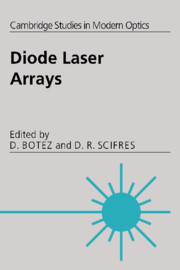Book contents
- Frontmatter
- Contents
- List of contributors
- Preface
- 1 Monolithic phase-locked semiconductor laser arrays
- 2 High-power coherent, semiconductor laser, master oscillator power amplifiers and amplifier arrays
- 3 Microoptical components applied to incoherent and coherent laser arrays
- 4 Modeling of diode laser arrays
- 5 Dynamics of coherent semiconductor laser arrays
- 6 High-average-power semiconductor laser arrays and laser array packaging with an emphasis on pumping solid state lasers
- 7 High-power diode laser arrays and their reliability
- 8 Strained layer quantum well heterostructure laser arrays
- 9 Vertical cavity surface-emitting laser arrays
- 10 Individually addressed arrays of diode lasers
- Index
Preface
Published online by Cambridge University Press: 10 November 2009
- Frontmatter
- Contents
- List of contributors
- Preface
- 1 Monolithic phase-locked semiconductor laser arrays
- 2 High-power coherent, semiconductor laser, master oscillator power amplifiers and amplifier arrays
- 3 Microoptical components applied to incoherent and coherent laser arrays
- 4 Modeling of diode laser arrays
- 5 Dynamics of coherent semiconductor laser arrays
- 6 High-average-power semiconductor laser arrays and laser array packaging with an emphasis on pumping solid state lasers
- 7 High-power diode laser arrays and their reliability
- 8 Strained layer quantum well heterostructure laser arrays
- 9 Vertical cavity surface-emitting laser arrays
- 10 Individually addressed arrays of diode lasers
- Index
Summary
Diode laser arrays have been studied for the last 15 years. Initially the interest was in creating phase-locked arrays of high coherent powers delivered in narrow, diffraction-limited beams for applications such as free-space optical communications. Around 1983 interest arose in spatially incoherent arrays as efficient pumps for solid-state lasers. This remains nowadays the most widespread use of diode laser arrays. In recent years there has been a demand for individually addressable one-dimensional and two-dimensional arrays to be used in parallel optical-signal processing, optical interconnects, and multichannel optical recording. We have attempted in this book to cover the development and features of all types of arrays demonstrated to date. The first five chapters treat various aspects of coherent arrays: lasers, amplifiers, external-cavity control, modeling and operational dynamics. Chapters 6–8 are dedicated primarily to spatially incoherent arrays. High-power capability, reliability, packaging and pumping schemes are discussed as they relate to the major application: solid-state-laser pumping. Individually addressable arrays of both the surface-emitting type (i.e. vertical-cavity surface emitters) and edgeemitting type are treated in Chapters 9 and 10, respectively.
Coherent arrays have proved a particularly challenging task. For the first ten years of research (1978–1988) the best that could be achieved was 50–100 mW in a diffraction-limited beam; that is, pretty much the same power as from a single-element device.
- Type
- Chapter
- Information
- Diode Laser Arrays , pp. xiii - xviPublisher: Cambridge University PressPrint publication year: 1994

